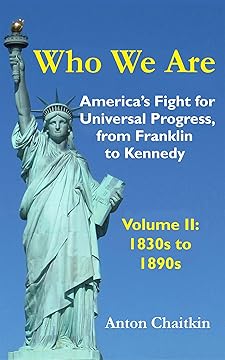Who We Are: America’s Fight for Universal Progress, From Franklin to Kennedy Volume II 1830s-1890s
By Anton Chaitkin (2025)
Book Review
(Part 3)
My favorite chapter in Who We Are concerns the role of Philadelphia supporters of the “American System” of political economy (see Lincoln: Expanding the Franklin/Hamilton “American System” to Make US World’s Leading Industrial Power) in fostering the career of inventor and entrepreneur Thomas Edison.
Early History
Thomas Edison was the son of a Canadian revolutionary named Samuel Edison who fled to Michigan after being charged with treason. After learning Morse code, Thomas became a telegraph operator at 15, also became a founding member of the National Telegraph Union at 18.
The Battle with J P Morgan
General William J Palmer, long time civil engineer for the Philadelphia railroads, hired Edison in 1870 to help him launch the Automatic Telegraph Company in competition with J P Morgan controlled Western Union.* Two of Edison’s inventions, the automatic printing telegraph and a technology to send multiple transmissions over a single wire were essential to this enterprise. In 1876, Palmer and other Philadelphia oil and railroad industrialists set him up in Menlo Park New Jersey. It was there Edison invented the carbon transmitter microphone, enabling the telephone invented by Alexander Graham Bell to carry a voice signal over long distances.
While at Menlo Park, Edison also developed the phonograph to record speech and the “telemachon,” a dynamo/generator capable of illuminating eight electric lights simultaneously. J P Morgan, who owned the patent on lightbulbs and a controlling interest in the natural gas used to light streets, blocked Edison’s efforts to manufacture lightbulbs. He was extremely wary of Edison’s ability to provide consumers with cheap electrical energy at a fraction of the cost of gas.
In response Edison sold his stock in the Edison Electric Light Company in 1880 to set up the Edison Lamp Works.
Edison Construction Company
Although his board opposed him, J P Morgan also sought to prohibit the building of any new generators in towns and cities. Edison now formed the Edison Construction Company, which supported local invests to set up generators in their own towns. In return for a fraction of their stock, Edison and his team would build their generators, operating pant and transmission networks. They then operated the plants for a brief period before turning them over to a local utility.
A mechanic named Henry Ford joined Detroit Edison when it first formed in 1886 and by 1894, he was their chief engineer.
Lincoln’s son Robert Todd formed Chicago Edison in 1887,
The US Government, a well as Edison and Philadelphia industrialist who supported them all facilitated electricity development in Europe, Mexico, South America and India and Africa.
The Development of Alternating Current and Edison’s Demise
When Thomas Houston and Westinghouse (who bought the patents from Tesla, a former Edison employee) promoted alternating current (AC) because it could be transmitted over longer distances. Unwisely Edison resisted adopting it in his own business, which proved unable to compete. J P Morgan eventually took over Edison’s entire enterprise (which he renamed General Electric) and froze Edison and his associates out of the businesses they had started. Morgan immediately put the brakes on expansion of electrical generation in favor of financial manipulation. This denied numerous sectors (farmers especially) access to electrical machinery for at least two decades. They would wait until the late 1920s, when governor Franklin Roosevelt renewed electrification efforts for residents of New York state. Southern electrification would wait until his 1932 election as president and the creation of the Tennessee Valley Authority.
*General William J Palmer was a Civil War veteran and civil engineer who built first bridge and across the Rio Grande and completed two-thirds of the railroad ink to Mexico City before a major attack by Boston financiers caused the financial collapse of his railroad
**Using the Pennsylvania Railroad right of way to construct telegraph poles and lines, Western Union completed the first transcontinental telegraph line in 1861. In the engineered depression that followed the Civil War, J P Morgan assumed a controlling interest in both the Pennsylvania Railroad and their Western Union spinoff.
Click this link for the original source of this article.
Author: stuartbramhall
This content is courtesy of, and owned and copyrighted by, https://stuartbramhall.wordpress.com and its author. This content is made available by use of the public RSS feed offered by the host site and is used for educational purposes only. If you are the author or represent the host site and would like this content removed now and in the future, please contact USSANews.com using the email address in the Contact page found in the website menu.








